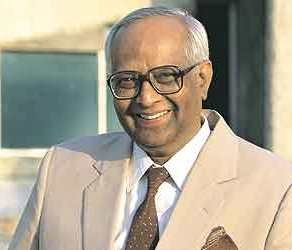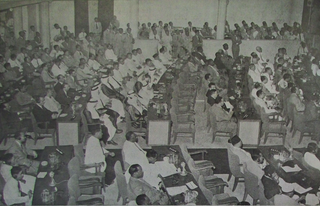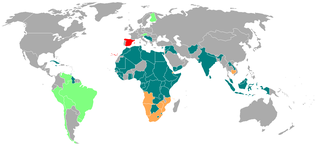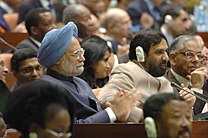
India, officially the Republic of India, has full diplomatic relations with 201 states, including Palestine, the Holy See, and Niue. The Ministry of External Affairs (MEA) is the government agency responsible for the conduct of foreign relations of India. With the world's third largest military expenditure, second largest armed force, fifth largest economy by GDP nominal rates and third largest economy in terms of purchasing power parity, India is a prominent regional power and a rising superpower.

Vengalil Krishnan Krishna Menon was an Indian academic, politician, and statesman described as the second most powerful man in India after the first Prime Minister of India, Jawaharlal Nehru, with whom he shared an intimate friendship, Before, during, and after India's independence, until his political collapse in 1962, Menon stood at the forefront of India's foreign relations, acknowledged domestically and internationally as India's de facto foreign minister and foreign policy architect, and acted as Nehru's personal plenipotentiary, capable of speaking with Nehru's voice and authority. Pre-1947, Menon led and represented the India League and broader Indian independence movement in London, advocating Indian independence before both the British parliament and public; towards the end of the 1940s, he became a dominant figure in Indo-British matters, even selecting the last British Viceroy of India, Earl Mountbatten of Burma, with whom he had long been friends.

Jyotindra Nath Dixit was an Indian diplomat, who as served as Foreign Secretary (1991–1994), the top bureaucrat in the Ministry of External Affairs. At the time of his death, he was the National Security Adviser (India) to the Prime Minister Manmohan Singh and is most remembered for his role as a negotiator in disputes with Pakistan and China.

The first large-scale Asian–African or Afro–Asian Conference —also known as the Bandung Conference—was a meeting of Asian and African states, most of which were newly independent, which took place on 18–24 April 1955 in Bandung, West Java, Indonesia. The twenty-nine countries that participated represented a total population of 1.5 billion people, 54% of the world's population. The conference was organized by Indonesia, Burma (Myanmar), India, Ceylon, and Pakistan and was coordinated by Ruslan Abdulgani, secretary general of the Ministry of Foreign Affairs of the Republic of Indonesia.

The Indo–Soviet Treaty of Peace, Friendship and Cooperation was a treaty signed between India and the Soviet Union in August 1971 that specified mutual strategic cooperation. This was a significant deviation from India's previous position of non-alignment during the Cold War and was a factor in the 1971 Indo-Pakistani war.

The Asian Relations Conference was an international conference that took place in New Delhi from 23 March to 2 April, 1947. Organized by the Indian Council of World Affairs (ICWA), the Conference was hosted by Jawaharlal Nehru, then the Vice-President of the interim Viceroy's Executive Council, and presided by Sarojini Naidu. Its goal was to promote cultural, intellectual and social exchange between Asian countries.
India was among the charter members of the United Nations that signed the Declaration by United Nations at Washington, D.C., on 1 January 1942 and also participated in the United Nations Conference on International Organization at San Francisco from 25 April to 26 June 1945. As a founding member of the United Nations, India strongly supports the purposes and principles of the UN and has made significant contributions in implementing the goals of the Charter, and the evolution of the UN's specialised programmes and agencies.
The History of Indian foreign policy refers to the foreign relations of modern India post-independence, that is the Dominion of India (from 1947 to 1950) and the Republic of India (from 1950 onwards).

The Socialist Federal Republic of Yugoslavia was one of the founding members of the Non-Aligned Movement. Its capital, Belgrade, was the host of the First Summit of the Non-Aligned Movement in early September 1961. The city also hosted the Ninth Summit in September 1989.
The 18th Summit of the Non-Aligned Movement was held October 25–26, 2019 in Baku, Azerbaijan. The summit was attended by the delegation from more than 120 countries.

The foreign policy of the Indira Gandhi government was the foreign policy of India between 1967 and 1977 during the Indira Gandhi premiership. It included a focus on security, by fighting militants abroad and strengthening border defenses. On 30 October 1981 at the meeting organised to mark silver jubilee celebration of the School of International Studies, Gandhi said, "A country’s policy is shaped by many forces- its position on the map, and the countries which are its neighbours, the policies they adopt, and the actions they take, as well as its historical experiences in the aggregate and in terms of its particular success or traumas."

Third Conference of the Non-Aligned Movement on 8–10 September 1970 in Lusaka, Zambia was the third conference of the Non-Aligned Movement. A preparatory meeting of Foreign Ministers drafted a number of resolutions which were considered by the Summit Conference. President of Zambia Kenneth Kaunda opened the conference by underlining non-alignment as "the natural choice at the time of increased hostility created by ideological conflicts in the bipolar world"

The Non-Aligned Movement (NAM) is a forum of 120 countries that are not formally aligned with or against any major power bloc. After the United Nations, it is the largest grouping of states worldwide.

6th Summit of the Non-Aligned Movement took place on 3–9 September 1979 in Havana, the capital city of Cuba. 93 countries took part in the summit. It was the first NAM summit which took place in one Iberoamerican country. The event was marked by political and ideological divisions among the non-aligned countries. The organizer wanted to use the event to propose "a natural alliance" between the movement and the Eastern Bloc causing strong resistance from some members, particularly SFR Yugoslavia. While both Cuba and Yugoslavia were at the time nominally socialist states, they took substantially different position in world politics with Cuba perceiving United States and Yugoslavia perceiving Soviet Union as the main threat to its independence.
1973 Non-Aligned Movement Standing Committee Conference took place on 13-15 May 1973 in Kabul, the capital city of Afghanistan. The country participated in the work of the movement since the 1st Summit of the Non-Aligned Movement in Belgrade in 1961. Afghanistan perceived Non-Alignment as a guaranty of peace in independence in the context in which the country shared a long border both with Soviet Union and CENTO member states. The 1973 meeting was opened by the Minister of Foreign Affairs of Afghanistan Mohammad Musa Shafiq. While serving as a host country, Afghanistan decided to nevertheless play marginal role in the event concerned how its more prominent role may be perceived by major powers. Delegation of Sri Lanka proposed Colombo as the host of the 5th Summit of the Non-Aligned Movement which was strongly supported by SFR Yugoslavia. Panama joined the NAM as an observer, while Bangladesh, despite reservations by Pakistan, joined as a full member state. Yugoslavia supported unofficial interest by Australia and North Korea to attend the next meeting with observer status. India, Guyana and SFR Yugoslavia played particularly active role in preparation of the working materials for the following summit in Algeria. Chile proposed inclusion of discussion on measures against global corporate threats and measures to protect sovereign control over natural resources. In July of the same year the host country was faced with 1973 Afghan coup d'état after which the new authorities stated their intention to maintain country's non-aligned position.

8th Summit of the Non-Aligned Movement on 1–6 September 1986 in Harare, Zimbabwe was the conference of heads of state or government of the Non-Aligned Movement. 101 countries took part in the summit, 51 of which were African countries. Explicitly expressed South–South cooperation call appeared for the first time in the 1986 NAM final declaration.
1961 Preparatory Meeting of the Non-Alignment Countries was held in Cairo, United Arab Republic from 5 to 12 June 1961 to discuss the goals of a policy of nonalignment ahead of the 1st Summit of the Non-Aligned Movement which will take place in September of the same year in Belgrade, SFR Yugoslavia. The goal of the meeting was to set common criteria for attendance at the Belgrade Conference with Cairo attendees division into two fractions of “inclusives” led by Nehru’s government of India and “exclusives” led by the Casablanca Group. Group led by India wanted for future summit to welcome neutral countries in Europe and if feasible multiple Latin American countries and for the event to focus on what was perceived by Indian representatives as grand and overarching issues of global consequence instead of more parochial concerns. Cuban and Guinean representatives were dominant in the “exclusives” group which wanted to focus on the issue of decolonization and criticism of the West Bloc.

Mediterranean island country of Cyprus was one of the founding members of the Non-Aligned Movement with Makarios III attending the 1st Summit of the Non-Aligned Movement in Belgrade, SFR Yugoslavia in 1961, just one year after the Cypriot independence. Membership in the movement was perceived as one of two major foreign-policy alternatives with the first one being formal membership in NATO at least nominally supported by both Greece and Turkey in the initial period after the London and Zürich Agreements and second one being pro-western participation in Non-Aligned Movement where United Kingdom and United States preferred this option at least until 1963.
Sri Lanka is one of the founding members of the Non-Aligned Movement. Principles of Non-Alignment and participation in movement's activities is of high priority in foreign policy of the country.
Tanzania is an active and prominent member state of the Non-Aligned Movement since the days of independence of Tanganyika in 1961. In early days of the movement President Julius Nyerere was recognized as one of the leading figures in the movement and among Third World leaders in general. His government promoted close adherence to non-alignment principles in which Global North and Global South division was more important than Cold War East–West dichotomy, supported African cooperation, engaged in a strong criticism of superpower intrusion in African affairs and supported the establishment of the New International Economic Order.

















